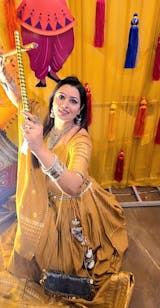Navratri, an auspicious and vibrant festival celebrated across India, is an occasion for joy, devotion, and cultural splendour. The festival lasts for nine nights and commemorates the goddess Durga and her many manifestations. During this period, people dressed in traditional clothing and participated in dance, music, and religious ceremonies. In addition to the many aspects that make Navratri unique, one stands out: the tradition of wearing red banarasi sarees. The sarees are more than a symbol of fashion; they also reflect the rich culture and tradition of Indian society.
Banarasi Sarees: A Timeless Elegance
The Banaras saree has been cherished for centuries due to its origins in Varanasi, also known as Banaras. It has been passed down through generations from artisans to weave these exquisite sarees in this city using techniques passed down from generation to generation. The Banarasi saree is renowned for its intricate weavings, silk fabrics, and gold and silver zari embellishment. A favourite choice for special occasions such as weddings, festivals, and cultural celebrations such as Navratri is their vibrant colours and artistic motifs.
The Significance of Red
Red, the colour of love, strength, and passion, holds a special place in Indian culture. It is often associated with goddesses like Durga, who is revered during Navratri. Red symbolizes auspiciousness, purity, and the triumph of good over evil. As a form of homage and prayer for prosperity and joy, wearing a red Banarasi saree during Navratri is a means of seeking her blessings.
The Weaving Process
Creating a Banarasi saree involves an intricate and laborious process requiring skilled craftsmanship. The sarees are woven with high-quality silk threads, and the patterns are meticulously made by hand. The intricate zari work of Banarasi sarees distinguishes them from other sarees. The fabric is woven with pure gold and silver threads to create striking motifs and borders. Sarees of this type can take weeks or even months to prepare, depending on their complexity and the level of craftsmanship involved.
Red Banarasi Sarees for Navratri
Red Banarasi sarees are the epitome of elegance and grace. Their deep, vibrant shade of red, combined with intricate zari work, makes them the perfect choice for Navratri celebrations. A red saree symbolizes the energy and enthusiasm of the festival, while zari work reflects the opulence and grandeur of the festival. Women who wear red Banarasi sarees not only look stunning, they feel connected to their cultural heritage and traditions as well.
Variety in Red Banarasi Sarees
Red Banarasi sarees come in different styles and designs. Some popular ones are:
Katan Silk Sarees:

Red katan silk sarees with intricate zari motifs are a classic choice for Navratri sarees, as they are woven with pure silk threads and made of a smooth texture and durable fabric.
Georgette Sarees:

Banarasi Georgette Sarees are lightweight and drape beautifully. They are usually embellished with delicate Zari work, making them a stylish yet comfortable choice for Navratri.
Organza Sarees:

A red Banarasi saree with minimalistic zari borders is a trendy choice for Navratri festivities since organza sarees are lightweight and sheer.
Brocade Sarees:

Red brocade Banarasi sarees are elegant and richly decorated with heavy zari work. These sarees are an excellent choice for special occasions such as Navratri and weddings.
Conclusion
Zeel Clothing offers a wide selection of red banarasi sarees for Navratri, which is not just a spiritual festival but a celebration of culture, devotion, and fashion. Red Banarasi sarees are crucial in this celebration because of their timeless elegance. Women who wear red Banarasi sarees during Navratri look exquisite and embrace India's rich heritage and traditions. Sarees are a cherished part of Navratri festivities because they symbolize the deep connection between fashion and culture. Pay homage to the goddess of this Navratri with the glorious beauty of a Red Banarasi Saree.









